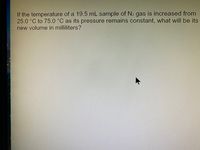
Chemistry
10th Edition
ISBN: 9781305957404
Author: Steven S. Zumdahl, Susan A. Zumdahl, Donald J. DeCoste
Publisher: Cengage Learning
expand_more
expand_more
format_list_bulleted
Concept explainers
Question

Transcribed Image Text:If the temperature of a 19.5 mL sample of N2 gas is increased from
25.0 °C to 75.0 °C as its pressure remains constant, what will be its
new volume in milliliters?
Expert Solution
This question has been solved!
Explore an expertly crafted, step-by-step solution for a thorough understanding of key concepts.
This is a popular solution
Trending nowThis is a popular solution!
Step by stepSolved in 2 steps

Knowledge Booster
Learn more about
Need a deep-dive on the concept behind this application? Look no further. Learn more about this topic, chemistry and related others by exploring similar questions and additional content below.Similar questions
- Based on the following equation, how many liters of NH3 can be produced from 15 liters of H2 at constant temperature and pressure? (use appropriate units in any conversions) N2(g) + 3H2(g) ⟶ 2NH3(g)arrow_forwardWhat is 32.0 psi of pressure in units of kilopascals (kPa)? Do not include the unit of measure in your answer.arrow_forwardA sample of oxygen gas initially at 391 K was heated to 445 K. If the volume of the oxygen gas sample at 445 K is 700.9 mL,what was its volume at 391 K?arrow_forward
- a sample of argon gas in a ballon has a volume of 336 mL at a temperature of 64.6 degrees Celsius. then the temperature is changed and the volume is increased to 617 mL. what is the new gas temperature in the balloon in Celsius.arrow_forwardOn average, a scuba tank provides 670 L of useful air. If a resting breathe has a volume of 0.50 L, how many breathes can a diver expect to get from a single scuba tank?arrow_forwardA sample of gas consisting of 5.51 mol occupies a volume of 11.73 L. If another sample of the same gas (under identical conditions) consists of 14.76 mol, what volume in litres of gas are in the second sample? Provide your answer with TWO decimals.arrow_forward
- If the temperature of a 15.0 mL sample of N₂ gas is increased from 25.0 °C to 75.0 °C as its pressure remains constant, what will be its new volume in milliliters?arrow_forwardUse correct number of significant figures. 1. A gas at constant temperature with a volume of 895.0mls and pressure of 750.0 torr has the pressure increased to 850.0 torr. What is its new volume in Liters? 2. At what temperature in °C does 0.505 moles of gas occupy a volume of 8.15 Liters at a pressure of 0.750 atm? 3. a) How many moles of Cl2 gas occupy a volume of 695 mL at 6.40 atm and 337 Kelvin? b. How many grams of Cl2 gas are present? 4. A gas at constant pressure occupies a volume of 200.0 mL at 27.0°C . At what temperature in °C would the volume be 280.0mL ?arrow_forwardIf 4.352 mol of argon gas occupies a volume of 111.1 liters at a particular temperature and pressure, what volume does 25.33 moles of argon occupy under the same condition?arrow_forward
- According to Dalton, the pressure exerted by a gas inside a container is proportional to the number of molecules of that gas. If 4.00 x 1023 molecules of N2 and 2.00 x 1023 molecules of O2 are mixed in a container they exert a total pressure of 1686 torr. What portion of that pressure (in torr units) is exerted by the N2? Report answer to four significant figures in decimal notation. _____________________ torr, What portion of that pressure (in torr units) is exerted by the O2? Report answer to four significant figures in decimal notation. ____________________ torrarrow_forwardA sample of carbon monoxide initially at 45.045.0 °C was heated to 90.090.0 °C. If the volume of the carbon monoxide sample is 796.4796.4 mL at 90.090.0 °C , what was its volume at 45.045.0 °C?arrow_forward
arrow_back_ios
arrow_forward_ios
Recommended textbooks for you
 ChemistryChemistryISBN:9781305957404Author:Steven S. Zumdahl, Susan A. Zumdahl, Donald J. DeCostePublisher:Cengage Learning
ChemistryChemistryISBN:9781305957404Author:Steven S. Zumdahl, Susan A. Zumdahl, Donald J. DeCostePublisher:Cengage Learning ChemistryChemistryISBN:9781259911156Author:Raymond Chang Dr., Jason Overby ProfessorPublisher:McGraw-Hill Education
ChemistryChemistryISBN:9781259911156Author:Raymond Chang Dr., Jason Overby ProfessorPublisher:McGraw-Hill Education Principles of Instrumental AnalysisChemistryISBN:9781305577213Author:Douglas A. Skoog, F. James Holler, Stanley R. CrouchPublisher:Cengage Learning
Principles of Instrumental AnalysisChemistryISBN:9781305577213Author:Douglas A. Skoog, F. James Holler, Stanley R. CrouchPublisher:Cengage Learning Organic ChemistryChemistryISBN:9780078021558Author:Janice Gorzynski Smith Dr.Publisher:McGraw-Hill Education
Organic ChemistryChemistryISBN:9780078021558Author:Janice Gorzynski Smith Dr.Publisher:McGraw-Hill Education Chemistry: Principles and ReactionsChemistryISBN:9781305079373Author:William L. Masterton, Cecile N. HurleyPublisher:Cengage Learning
Chemistry: Principles and ReactionsChemistryISBN:9781305079373Author:William L. Masterton, Cecile N. HurleyPublisher:Cengage Learning Elementary Principles of Chemical Processes, Bind...ChemistryISBN:9781118431221Author:Richard M. Felder, Ronald W. Rousseau, Lisa G. BullardPublisher:WILEY
Elementary Principles of Chemical Processes, Bind...ChemistryISBN:9781118431221Author:Richard M. Felder, Ronald W. Rousseau, Lisa G. BullardPublisher:WILEY

Chemistry
Chemistry
ISBN:9781305957404
Author:Steven S. Zumdahl, Susan A. Zumdahl, Donald J. DeCoste
Publisher:Cengage Learning

Chemistry
Chemistry
ISBN:9781259911156
Author:Raymond Chang Dr., Jason Overby Professor
Publisher:McGraw-Hill Education

Principles of Instrumental Analysis
Chemistry
ISBN:9781305577213
Author:Douglas A. Skoog, F. James Holler, Stanley R. Crouch
Publisher:Cengage Learning

Organic Chemistry
Chemistry
ISBN:9780078021558
Author:Janice Gorzynski Smith Dr.
Publisher:McGraw-Hill Education

Chemistry: Principles and Reactions
Chemistry
ISBN:9781305079373
Author:William L. Masterton, Cecile N. Hurley
Publisher:Cengage Learning

Elementary Principles of Chemical Processes, Bind...
Chemistry
ISBN:9781118431221
Author:Richard M. Felder, Ronald W. Rousseau, Lisa G. Bullard
Publisher:WILEY